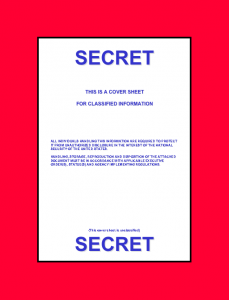Every year United States government agencies add petabytes of classified information (a petabyte equals 20 million four drawer filing cabinets, all of which will be subject to a future declassification review. If you hold a U.S. government national security clearance there is a high probability that you will be touching some of these documents in the course of your normal duties.
And if you are a government employee you may have the responsibility of that of classifying authority, and if you are a contractor you will more than likely be exposed to the derivative classification activities. In either case, it is incumbent upon the, you the individual creating a document, to validate the need to classify the information. The number one problem with respect to government classification systems is the over classification of information, meaning, information which does not require the heightened level of security (and the attendant expense associated) is incorrectly/inappropriately anointed with a security classification.
You may be wondering, where can I learn about the rules surrounding classification and declassification, as you certainly don’t want to needlessly add to the mountains of classified documents? Your first stop is President Obama’s executive order 13526 (EO-13526) on Classifying National Security Information [2] which details the rules of the road. Then you may want to read two recent reports, the first is from the Public Interest Declassification Board (PIDB) and their “Transforming Classification – 2012 Report to the President”[3] which contains a number of recommendations, many of which are discussed on the PIDB website. [4]
Interestingly, the classification system we currently use was created in 1953 and has been a topic of much discussion over the years.
“Despite the best of intentions, the classification system, largely unchanged since the Eisenhower administration, has grown out of control. More information is being classified and for extended periods of time. Security rules proliferate, becoming more complex yet remaining unrelated to the threat. Security costs increase as inconsistent requirements are imposed by different agencies or by different program managers within the same agency.
This accretion of security rules and requirements to protect classified information does not make the system work better. Indeed, the classification system is not trusted on the inside any more than it is on the outside. Insiders do not trust it to protect information that needs protection. Outsiders do not trust it to release information that does not need protection.
This Cold War classification system can be simplified.”
-Redefining Security, A Report to the Secretary of Defense and the Director of Central Intelligence, February 28, 1994, Joint Security Commission
The salient point being, every document which carries a US government classification marking will be reviewed at some later date, be it 10, 20, 50 years from now by a government information officer (or their technical toolsets which evolve) to determine the continued need to have the information classified. According to the aforementioned report, one reviewing officer can process 10 four-drawer cabinets full of documents in one calendar year. Therefore, it is easy to understand why unnecessary classification of information adds both cost and resource expenditure. And while running up the cost should be sufficient incentive, the report also states over classification also erodes the public trust. A public who expects their government to be open and transparent (save for those instances of bonafide national security issue).





